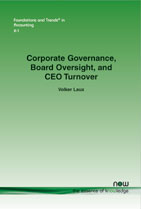Corporate Governance, Board Oversight, and CEO Turnover
By Volker Laux, University of Texas at Austin, USA, Volker.Laux@mccombs.utexas.edu
Abstract
One of the primary roles of corporate boards is to control the processes by which top executives are assessed and if necessary replaced. CEO turnover cannot be viewed in isolation because it affects the behavior of the involved players and hence interacts with other organizational goals. This monograph seeks to synthesize recent research that analyzes these interactions. I focus on a number of recurring themes, including the implications of CEO assessment and replacement on optimal contracting, board monitoring, project selection, financial reporting, and CEO selection.
Corporate Governance, Board Oversight, and CEO Turnover
Corporate Governance, Board Oversight, and CEO Turnover reviews the interactions between Board of Director’s role in governance and oversight, executive evaluation, and organizational goals including truthful disclosure of earnings and investment in long-term projects. It synthesizes recent research that examines these interactions and their implications on: 1. firms’ investment strategies, 2. executive compensation packages, 3. board monitoring and transparency, 4. the likelihood and characteristics of CEO turnover, 5. financial reporting, 6. CEO selection, and 7. board composition.
Corporate Governance, Board Oversight, and CEO Turnover analyzes governance from the perspective of assessment. The analysis is framed around themes related to CEO assessment and replacement. Each theme is the focus of one section. Section 2 studies the costs of transparency in a setting in which the board seeks to assess the CEO and, if warranted, replace him. Section 3 studies a setting in which the CEO privately observes an earnings signal and issues a public report about earnings. Section 4 focuses on the interaction between assessment and replacement with other organizational strategies, such as the firms' investments strategies. Section 5 shows that linking CEO turnover to a change in firm strategy can be optimal even when the incumbent is as qualified to implement the new strategy as the replacement CEO. Section 6 shows that the increased risk of hiring from the outside is not necessarily a disadvantage but can be an advantage because the board has the option of replacing the new hire at a future date. Section 7 concludes.
Overall, Corporate Governance, Board Oversight, and CEO Turnover sheds light on firms' observed practices that, viewed in isolation, seem counterproductive or inefficient by analyzing governance from the perspective of assessment and replacement.
